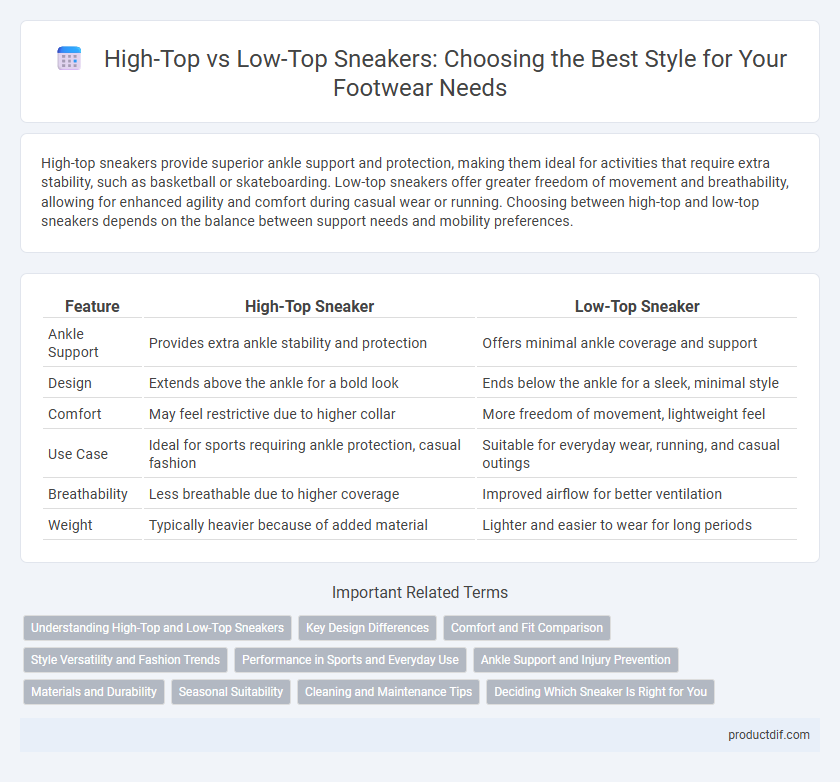High-top sneakers provide superior ankle support and protection, making them ideal for activities that require extra stability, such as basketball or skateboarding. Low-top sneakers offer greater freedom of movement and breathability, allowing for enhanced agility and comfort during casual wear or running. Choosing between high-top and low-top sneakers depends on the balance between support needs and mobility preferences.
Table of Comparison
| Feature | High-Top Sneaker | Low-Top Sneaker |
|---|---|---|
| Ankle Support | Provides extra ankle stability and protection | Offers minimal ankle coverage and support |
| Design | Extends above the ankle for a bold look | Ends below the ankle for a sleek, minimal style |
| Comfort | May feel restrictive due to higher collar | More freedom of movement, lightweight feel |
| Use Case | Ideal for sports requiring ankle protection, casual fashion | Suitable for everyday wear, running, and casual outings |
| Breathability | Less breathable due to higher coverage | Improved airflow for better ventilation |
| Weight | Typically heavier because of added material | Lighter and easier to wear for long periods |
Understanding High-Top and Low-Top Sneakers
High-top sneakers provide enhanced ankle support and protection, making them ideal for activities requiring stability and injury prevention. Low-top sneakers offer greater flexibility and breathability, suited for casual wear and activities emphasizing speed and agility. Choosing between high-top and low-top designs depends on the balance between support needs and mobility preferences.
Key Design Differences
High-top sneakers feature an extended collar that covers the ankle, providing enhanced support and protection, often preferred for activities requiring stability. Low-top sneakers have a cut below the ankle, offering greater freedom of movement and a lighter feel, making them ideal for casual wear and running. The choice between high-top and low-top designs impacts flexibility, support, and overall foot coverage, influencing performance and style.
Comfort and Fit Comparison
High-top sneakers provide enhanced ankle support and a secure fit, making them ideal for activities requiring stability, while low-top sneakers offer greater freedom of movement and a lightweight feel. Comfort in high-tops often comes from padded collars and cushioned insoles, whereas low-tops excel in breathability and flexibility due to fewer materials around the ankle. Choosing between these styles depends on the wearer's need for support versus mobility, with both offering tailored cushioning technologies for optimal foot comfort.
Style Versatility and Fashion Trends
High-top sneakers offer a bold, street-style aesthetic that pairs well with casual and urban fashion, making them popular in contemporary streetwear trends. Low-top sneakers provide greater style versatility, effortlessly complementing both casual outfits and more polished looks, which keeps them a timeless choice in fashion. Current trends show a resurgence of retro-inspired high-tops, while low-tops maintain steady demand due to their classic silhouette and adaptability.
Performance in Sports and Everyday Use
High-top sneakers provide superior ankle support and stability, making them ideal for sports like basketball and skateboarding where lateral movements and jumps are frequent. Low-top sneakers offer greater flexibility and lighter weight, enhancing speed and agility for activities such as running and casual wear. Choosing between high-top and low-top designs depends on the balance between needed ankle protection and freedom of movement for specific sports or everyday use.
Ankle Support and Injury Prevention
High-top sneakers provide enhanced ankle support by covering and stabilizing the ankle joint, reducing the risk of sprains during physical activities. Low-top sneakers offer greater freedom of movement but lack the structured support needed to prevent ankle injuries effectively. Athletes prone to ankle instability often prefer high-tops for better protection and injury prevention.
Materials and Durability
High-top sneakers typically feature reinforced materials like leather or synthetic overlays that provide enhanced ankle support and greater durability for rugged use. Low-top sneakers often utilize lighter materials such as mesh or canvas, prioritizing breathability and flexibility but generally offering less structural protection. The choice of materials in high-tops contributes to extended wear resistance, while low-tops emphasize comfort and ease of movement with modest durability.
Seasonal Suitability
High-top sneakers offer enhanced ankle support and extra coverage, making them ideal for colder seasons like fall and winter by providing warmth and protection against the elements. Low-top sneakers, with their lightweight and breathable design, suit warmer months such as spring and summer, allowing better air circulation and comfort during higher temperatures. Choosing between high-top and low-top sneakers depends on seasonal demands, balancing insulation and ventilation needs.
Cleaning and Maintenance Tips
High-top sneakers require more attention to cleaning due to their extended ankle coverage, which traps dirt and sweat more easily than low-top sneakers. Use a soft brush to remove debris from seams and employ a damp cloth to clean the leather or canvas surfaces, ensuring thorough drying to prevent odor and material damage. Low-top sneakers benefit from regular wiping and occasional deep cleaning with mild detergent, focusing on sole edges and fabric to maintain breathability and prolong shoe lifespan.
Deciding Which Sneaker Is Right for You
High-top sneakers provide enhanced ankle support and stability, making them ideal for activities requiring extra protection, while low-top sneakers offer greater freedom of movement and lighter weight for casual wear and running. Consider your specific needs such as athletic performance, daily comfort, and style preferences when choosing between these sneaker types. Material quality, sole design, and arch support also significantly affect overall comfort and functionality.
High-Top Sneaker vs Low-Top Sneaker Infographic

 productdif.com
productdif.com